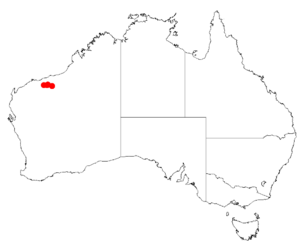Leeuwen's wattle facts for kids
Quick facts for kids Leeuwen's wattle |
|
|---|---|
| Conservation status | |
| Scientific classification | |
| Genus: |
Acacia
|
| Species: |
leeuweniana
|
 |
|
| Occurrence data from AVH | |
The Leeuwen's wattle (scientific name: Acacia leeuweniana), also called Spear Hill wattle, is a special type of tree. It belongs to the Acacia family. This tree is found only in a small part of north-western Australia. When a plant or animal is found only in one specific area, it is called endemic.
Contents
What Does Leeuwen's Wattle Look Like?
This tree is usually narrow and shaped like a cone. It can grow quite tall, up to about 14 meters (46 feet). It often has one main trunk, but sometimes a few trunks grow from its base.
The bark of the Leeuwen's wattle is interesting. It starts out brownish or reddish. As the tree gets older, the bark peels off in thin, curly pieces. These pieces then turn a grey color. The small branches are round and break easily. They have faint ridges.
The leaves of the Leeuwen's wattle are green to grey-green. They are mostly long and thin, like a line. They can be from 7 to 15 centimeters (2.8 to 5.9 inches) long. They are very narrow, only 1 to 2.5 millimeters (0.04 to 0.1 inches) wide. These leaves have many very fine lines running along them.
Flowers and Seeds
Leeuwen's wattle trees usually bloom between April and May. They can also flower as late as October. Scientists think they bloom after it rains. Their flowers grow in spikes, which are like small clusters. These spikes are about 10 to 20 millimeters (0.4 to 0.8 inches) long. The flowers themselves are a light golden color.
After the flowers, seed pods grow. These pods are light grey-brown and feel a bit woody. They are shaped like a wide line and can be 3 to 10 centimeters (1.2 to 3.9 inches) long. They are about 6 to 8 millimeters (0.2 to 0.3 inches) wide. The pods are slightly curved and smooth. They also have a sticky, resin-like substance on them. You can see a clear line along the edge of the pod.
Inside the pods are shiny brown seeds. They are arranged lengthwise and are shaped like a small oval. These flattened seeds are quite large, about 7 to 11 millimeters (0.3 to 0.4 inches) long. They are 3 to 5 millimeters (0.1 to 0.2 inches) wide.
How Did It Get Its Name?
The scientific name leeuweniana was given to honor Stephen van Leeuwen. He was a scientist who studied plants in the Pilbara region. He helped us learn a lot about the plants that grow there. This tree is also closely related to another type of wattle called Acacia cyperophylla.
Where Does Leeuwen's Wattle Grow?
Leeuwen's wattle is found in a small part of the Pilbara region. This area is in Western Australia. The trees like to grow among large rocks called boulders. You can find them in rocky areas, often growing in cracks in the ground. They prefer sandy or gravelly soils that are very thin, usually over or around granite rock.


